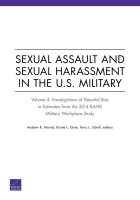| 来源类型 | Research Reports
|
| 规范类型 | 报告
|
| DOI | https://doi.org/10.7249/RR870.6
|
| ISBN | 9780833092793
|
| 来源ID | RR-870/6-OSD
|
| Sexual Assault and Sexual Harassment in the U.S. Military: Volume 4. Investigations of Potential Bias in Estimates from the 2014 RAND Military Workplace Study |
| Andrew R. Morral; Kristie Gore; Terry L. Schell; Amy Grace Donohue; Marc N. Elliott; Caroline Batka; Coreen Farris; Bonnie Ghosh-Dastidar; Lisa H. Jaycox; Dean Kilpatrick
|
| 发表日期 | 2016
|
| 出版年 | 2016
|
| 页码 | 268
|
| 语种 | 英语
|
| 结论 |
We found no conclusive evidence of substantial bias or error in previously reported RMWS estimates- There was, however, a general pattern that suggests the primary RMWS estimates of sexual assault, sexual harassment, and gender discrimination are more likely to be underestimates than overestimates of true population values.
We found little evidence that the study overcounted rates of sexual assault, sexual harassment, and gender discrimination- For example, although we concluded that a small number of pre-service sexual assaults may be captured in our estimates, this number is almost certainly lower than the larger number of assaults that go uncounted because we excluded members with fewer than six months of service and those who left the military shortly before the survey fielded.
A substantial portion of any underestimation of sexual assault rates in the military is attributable to our use of a sample frame that excludes some high-risk service members- The strongest evidence for bias comes from the fact that the survey sample frame clearly excluded some individuals who served in the military in the past year and who may have experienced a sexual assault. This source of bias may explain a substantial proportion of the total survey error identified by our comparison of survey-estimated counts of reported sexual assault to official reports of sexual assault.
We report evidence that the methods we used to weight survey respondents produced less-biased estimates than the conventional approach to weighting military surveys- In particular, the analysis of nonresponses weights found that the conventional sample weighting methods resulted in the underrepresentation of a number of groups of service members who have a high risk for sexual assault and harassment.
|
| 摘要 |
- Future surveys of sexual assault and sexual harassment should use the RMWS measurement approach, or comparable survey questions that use behaviorally and anatomically specific language to clearly define criminal sexual assault and violations of equal opportunity law and policy.
- Omitting service members who recently separated from the military could lead to significant bias in estimates of past-year sexual assaults, sexual harassment, and gender discrimination. As a result, we recommend including past-year separations in the sample frame of future surveys, or developing analytic approaches for estimating the number of crimes and violations those who separated experienced in the past year.
- The Defense Manpower Data Center (DMDC) should design future surveys to include sufficient numbers of men in the sample to ensure ongoing assessment of the nature of sexual assaults against them. In practice, this means large sample surveys that may not oversample women at rates as great as in the RMWS or previous WGRA studies. This can be done without reducing the precision of women's estimates below those of men.
- DMDC should build on approaches developed for the RMWS to include a wider set of factors in future nonresponse weighting models than has previously been possible for military surveys.
- The Office of the Secretary of Defense (OSD), the Defense Information Systems Agency, and the services should collaborate to improve the coverage and reliability of email contact information in the personnel systems used for survey recruitment. Also, DMDC should investigate additional modes of recruitment (phone or text message) that improve outreach to members who do not routinely use email as part of their military duties.
- In future surveys on sexual assault, DMDC should continue to compare survey estimates with actual numbers of filed Victim Reporting Preference forms as a measure of nonresponse bias and total survey error more generally.
- OSD should conduct the survey no more frequently than once every two to four years.
|
| 主题 | Gender Discrimination
; Gender Equity in the Workplace
; Military Justice
; Military Personnel
; Sexual Assault
; Sexual Harassment
; Workforce Diversity
; Workforce Management
|
| URL | https://www.rand.org/pubs/research_reports/RR870z6.html
|
| 来源智库 | RAND Corporation (United States)
|
| 引用统计 |
|
| 资源类型 | 智库出版物
|
| 条目标识符 | http://119.78.100.153/handle/2XGU8XDN/108435
|
推荐引用方式
GB/T 7714 |
Andrew R. Morral,Kristie Gore,Terry L. Schell,et al. Sexual Assault and Sexual Harassment in the U.S. Military: Volume 4. Investigations of Potential Bias in Estimates from the 2014 RAND Military Workplace Study. 2016.
|
|
文件名:
|
x1537531930936.jpg
|
|
格式:
|
JPEG
|

|
文件名:
|
RAND_RR870z6.pdf
|
|
格式:
|
Adobe PDF
|
除非特别说明,本系统中所有内容都受版权保护,并保留所有权利。